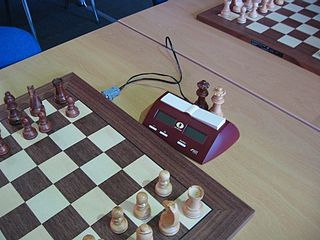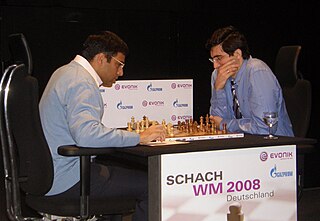In chess, a fork is a tactic in which a piece attacks multiple enemy pieces simultaneously. The attacker usually aims to capture one of the forked pieces. The defender often cannot counter every threat. A fork is most effective when it is forcing, such as when the king is put in check. A fork is a type of double attack.
In chess, a pin is a tactic in which a defending piece cannot move out of an attacking piece's line of attack without exposing a more valuable defending piece. Moving the attacking piece to effect the pin is called pinning; the defending piece restricted by the pin is described as pinned. Only a piece that can move any number of squares along a horizontal, vertical, or diagonal line can pin. Any piece can be pinned except the king. The pin is one of the most powerful chess tactics.
Stalemate is a situation in chess where the player whose turn it is to move is not in check and has no legal move. Stalemate results in a draw. During the endgame, stalemate is a resource that can enable the player with the inferior position to draw the game rather than lose. In more complex positions, stalemate is much rarer, usually taking the form of a swindle that succeeds only if the superior side is inattentive. Stalemate is also a common theme in endgame studies and other chess problems.

Viswanathan "Vishy" Anand is an Indian chess grandmaster, a former five-time World Chess Champion and a record two-time Chess World Cup Champion. He became the first grandmaster from India in 1988, and he has the eighth-highest peak FIDE rating of all time. In 2022, he was elected the deputy president of FIDE.

Veselin Aleksandrov Topalov is a Bulgarian chess grandmaster and former FIDE World Chess Champion.

Gata Kamsky is a Soviet-born American chess grandmaster, and a five-time U.S. champion.
In chess, a tactic is a sequence of moves that each makes one or more immediate threats – a check, a material threat, a checkmating sequence threat, or the threat of another tactic – that culminates in the opponent's being unable to respond to all of the threats without making some kind of concession. Most often, the immediate benefit takes the form of a material advantage or mating attack; however, some tactics are used for defensive purposes and can salvage material that would otherwise be lost, or to induce stalemate in an otherwise lost position.
Petrov's Defence or the Petrov Defence is a chess opening characterised by the following moves:
The Catalan Opening is a chess opening where White plays d4 and c4 and fianchettoes the white bishop on g2. A common opening sequence is 1.d4 Nf6 2.c4 e6 3.g3, although various other openings can transpose into the Catalan. The Encyclopaedia of Chess Openings (ECO) lists codes E01–E09 for lines with 1.d4 Nf6 2.c4 e6 3.g3 d5 4.Bg2; other lines are part of E00.
The two knights endgame is a chess endgame with a king and two knights versus a king. In contrast to a king and two bishops, or a bishop and a knight, a king and two knights cannot force checkmate against a lone king. Although there are checkmate positions, a king and two knights cannot force them against proper, relatively easy defense.
In chess, an isolated pawn is a pawn that has no friendly pawn on an adjacent file. Isolated pawns are usually a weakness because they cannot be protected by other pawns. The square in front of the pawn may become a good outpost for the opponent to anchor pieces. Isolated pawns most often become weaker in the endgame, as there are fewer pieces available to protect the pawn.

In chess, promotion is the replacement of a pawn with a new piece when the pawn is moved to its last rank. The player replaces the pawn immediately with a queen, rook, bishop, or knight of the same color. The new piece does not have to be a previously captured piece. Promotion is mandatory when moving to the last rank; the pawn cannot remain as a pawn.
In chess, a sacrifice is a move that gives up a piece with the objective of gaining tactical or positional compensation in other forms. A sacrifice could also be a deliberate exchange of a chess piece of higher value for an opponent's piece of lower value.
In chess, the exchange is the material difference of a rook for a minor piece. Having a rook for a minor piece is generally advantageous, since the rook is usually more valuable. A player who has a rook for a minor piece is said to be up the exchange, and the other player is down the exchange. A player who wins a rook for a minor piece is said to have won the exchange, while the other player has lost the exchange. The opposing captures often happen on consecutive moves, but this is not strictly necessary. Although it is generally detrimental to lose the exchange, one may occasionally find reason to purposely do so; the result is an exchange sacrifice.
In chess, a blunder is a critically bad mistake that severely worsens the player's position by allowing a loss of material, checkmate, or anything similar. It is usually caused by some tactical oversight, whether due to time trouble, overconfidence, or carelessness. Although blunders are most common in beginner games, all human players make them, even at the world championship level. Creating opportunities for the opponent to blunder is an important skill in over-the-board chess.

The World Chess Championship 2006 was a match between Classical World Chess Champion Vladimir Kramnik and FIDE World Chess Champion Veselin Topalov. The title of World Chess Champion had been split for 13 years. This match, played between September 23 and October 13, 2006, in Elista, Kalmykia, Russia, was to reunite the two World Chess Champion titles and produce an undisputed World Champion.

The World Chess Championship 2008 was a best-of-twelve-games match between the incumbent World Chess Champion, Viswanathan Anand, and the previous World Champion, Vladimir Kramnik. Kramnik had been granted a match after not winning the World Chess Championship 2007 tournament.
This article documents the progress of significant human–computer chess matches.
Many basic tactics of shogi are similar to those of chess tactics, involving forks, pins, removing the defender and other techniques, all of which are considered very strong when used effectively.






